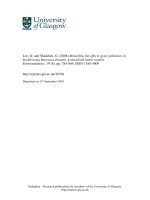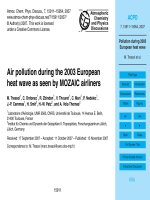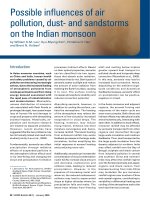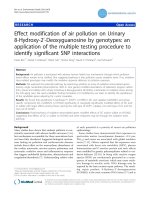TREES — THE AIR POLLUTION SOLUTION pot
Bạn đang xem bản rút gọn của tài liệu. Xem và tải ngay bản đầy đủ của tài liệu tại đây (1.17 MB, 4 trang )
TREES — THE
AIR POLLUTION
SOLUTION
Millions of us live in areas where
air pollution can cause serious
health problems. Ground-level ozone
and airborne particles are two pollutants that
pose the greatest threat to human health. Carbon
dioxide (CO
2
), once thought to be the product of perfect
combustion, is also now considered a pollution concern.
Fortunately, trees play an important role in cleaning the air and
making our communities healthier places to live. This publication explores how trees
clean air and how we can increase their role as air pollution control devices.
Center for
Urban Forest Research
OZONE is not emitted directly, but is
created by chemical reactions between
oxides of nitrogen (NOx) and volatile
organic compounds (VOCs) in sunlight.
The rate of ozone formation is increased
by higher air temperatures. Emissions
from industrial facilities and electric
utilities, motor vehicle exhaust, gas
vapors, and chemical solvents are some
major sources of NOx and VOCs.
PARTICULATES Particle pollution
consists of microscopic solids or liquid
droplets so small that they can be
inhaled deep into our lungs, causing
serious health problems. Most of them
start as smoke and diesel soot and form
in the air from NOx and sulfur oxides
(SOx), even obscuring our visibility.
CO
2
is a greenhouse gas that traps the
earth’s heat and contributes to global
warming. Human activities add green-
house gases to the atmosphere at a rate
of about 3 percent of annual natural
emissions — enough to tip the balance
and overwhelm the environment.
CO
2
REDUCTION
Community trees reduce atmospheric
CO
2
by storing it or by reducing demand
for heating and cooling. On the other
hand, vehicles, chain saws, chippers,
and other equipment release CO
2
during
the process of planting and maintaining
trees. And eventually, all trees die and
most of the CO
2
that has accumulated
in their woody biomass is released into
the atmosphere through decomposition.
A comprehensive study of these
“opposing” effects was conducted in
Sacramento County, California. Its
6 million trees contribute to an annual
net reduction of CO
2
by about 335,000
tons. Of that total, 262,300 tons of CO
2
remain sequestered in the trees. But, the
encouraging piece of this annual
reduction is that an additional 83,300
tons — nearly 25% of the reduction — is
attributable to tree shade on homes,
buildings, and other structures. The CO
2
released due to tree planting,
maintenance, and other program-related
activities is only about 2 – 8 percent of
annual CO
2
reductions and the release of
CO
2
through decomposition accounts for
only another 1 percent. So, the total CO
2
released in Sacramento County is less
than 10,600 tons per year.
OZONE & PARTICULATE REDUCTION
Three factors principally affect the
uptake of ozone and particulates:
concentrations of pollutants, canopy
cover, and “surface roughness.”
Sacramento County’s 6 million trees
remove approximately 1,607 tons of air
pollutants annually. As expected, they
were most effective at removing ozone
and particulate matter (PM
10
). These
trees removed 665 tons of ozone and 748
tons of PM
10
.
WHAT IS THIS SERVICE WORTH?
Our findings indicate that the reduction
of atmospheric CO
2
by the 6 million trees
in Sacramento County has a current
annual value of $3.3 million. That means
that each tree’s contribution is worth
$0.55/yr on average. The total value of the
annual reduction of ozone and particle
pollution is $28.7 million, or nearly $5
per tree on average. However, it is
important to understand that even
though trees are highly efficient at
reducing air pollution, their contribution
to the overall reduction of air pollutants
is fairly small, amounting to only about
2 percent of the total emitted. Nearly
98% of air pollution is currently not
being “treated” by trees.
THE POLLUTANTS
THE TREE SOLUTION
Get trees into your State Implementation Plan:
1. Conduct a resource assessment. Assess
the current canopy cover in your Air
Quality Management District (AQMD).
Determine how many potential sites could
be successfully planted or regenerated.
2. Develop a range of planting scenarios
representing business as usual, and
selected future plantings to determine
the impact of different species mixes and
tree densities on air quality 10 to 40 years
in the future.
3. Model the effects of planting scenarios
on air quality. Using data in the canopy
cover assessment, conduct a modeling
analysis to account for the following:
• Impacts of air temperature changes
on atmospheric chemistry including
formation of ozone, other oxidants
and particulate matter.
• Impacts of deposition (removal of
pollutants from the atmosphere)
changes on air pollutant
concentrations.
• Impacts of increased tree cover on
biogenic volatile organic compounds
(BVOCs) emissions. Emissions of
BVOCs are of concern because they
are precursors to ozone and
particulate matter formation.
• Impacts of avoided emissions
changes. Avoided emissions may
occur because of reduced urban
temperatures resulting from increased
tree cover. Examples include reduced
mobile source emissions and reduced
emissions related to power generation
for air contitioning.
4. Develop a plan to increase tree canopy
cover based on the modeling. Be sure to
consider the number to plant, where to
plant, species (particularly the high
emitters of BVOCs), growth, ultimate
size, maintenance requirements, and
mortality. For information on tree selec-
tion go to:
5. Consider developing a database to
account for new plantings and a change
in tree canopy cover. This program
evaluation will be required to verify
that the estimated increase in canopy is
attained. One idea being used in
Houston is a web-based system for
tracking new plantings.
6. Submit measure within your State
Implementation Plan (SIP). Since trees
are new to the SIP process, work with
your EPA regional office and local
AQMD to develop your tree canopy
enhancement program.
Consider both urban forestry options —
new tree plantings and preservation of canopy.
1. New tree plantings include all trees
added to your area, both public and
private. Be sure to count any natural
regeneration.
2. Preservation of canopy is a totally
different approach. The goal here is to
maintain existing canopy cover and
you must demonstrate that canopy was
preserved by incorporating various
urban development strategies. In other
words, a predetermined loss of canopy
was avoided because of your intervention.
Increase the traditional tree planting
programs in your state.
Don’t stop what you are already doing.
Make a good thing better.
Think extremely long term (40-50 years).
Once you have reached attainment,
planting millions of trees to mitigate air
pollution will be part of a long-term plan.
Bad air quality is a regional problem that
requires a regional solution, especially one
requiring millions of trees. Communities
must work together in public-private
partnerships to achieve better air quality.
Develop a Greenprint project for your
region or state.
Greenprint in the Sacramento, California
region is a great example of how to
establish a regional coalition. Greenprint
invites a region’s cities and counties to
develop livable and sustainable communities
by building the best urban forests.
Adequate tree canopy contributes to a
healthy community. For more on
Greenprint go to:
/>ervices/greenprint/STF_GP_broch_v12.pdf
Continue caring for and nurturing your
existing trees.
They already provide the benefits you are
seeking. The air pollution solution is to
add more of them.
Follow the progress we are making
as a nation.
Periodically visit our partnership
website at:
THE STRATEGY: The Planting Solution
THE STRATEGY: The Planting Solution
Center for Urban Forest Research
Pacific Southwest Research Station,
USDA Forest Service, MS-6
1 Shields Avenue, Suite 1103
Davis, CA 95616-8587
(530) 752-7636 • Fax (530) 752-6634
/>The United States Department of Agriculture (USDA) prohibits discrimina-
tion in all its programs and activities on the basis of race, color, national
origin, gender, religion, age, disability, political beliefs, sexual orientation and
marital or family status. (Not all prohibited bases apply to all programs.)
Persons with disabilities who require alternative means for communication
of program information (Braille, large print, audiotape, etc.) should contact
USDA’s TARGET Center at: (202) 720-2600 (voice and TDD). To file a complaint
of discrimination, write: USDA Director, Office of Civil Rights, Room 326-
W, Whitten Building, 14th and Independent Avenue, SW, Washington, DC
20250-9410, or call: (202) 720-5964 (voice or TDD).
USDA is an equal opportunity provider
and employer. January 2006
RESOURCES
Geiger, J.R. 2002. Green plants or power
plants? Davis, CA: Center for Urban Forest
Research, Pacific Southwest Research Station,
USDA Forest Service; 4p. Research summary.
/>ucts/3/cufr_148.pdf
Geiger, J.R. 2002. Where are all the cool park-
ing lots? Davis, CA: Center for Urban Forest
Research, Pacific Southwest Research Station,
USDA Forest Service; 4p. Research summary.
/>ucts/3/cufr_151.pdf
McPherson, E.G., D.J. Nowak, and R.A.
Rowntree. 1994. Chicago's urban forest ecosys-
tem: results of the Chicago urban forest climate
project. Part 2. NE GTR-186. Radnor, PA: USDA
Forest Service, Northeastern Forest Experiment
Station, 201. />grams/cufr/products/cufr_188_gtr186a.pdf
McPherson, E.G. 1998. Atmospheric
carbon dioxide reduction by Sacramento's urban
forest. Journal of Arboriculture. 24(4): 215-223.
/>ucts/cufr_26_EM98_9.pdf
McPherson, E.G. and J.R. Simpson. 2003.
Potential energy savings in buildings by an
urban tree planting programme in California.
Urban & Fischer Verlag. Urban Green. 2 (2003)L
073-086.
/>ucts/cufr_415_energy-savings.pdf
Nowak, D.J. 2005. Strategic tree planting as an
EPA encouraged pollutant reduction strategy:
How urban trees can obtain credit in State
Implementation Plans. Syracuse, NY:
Northeastern Research Station, USDA Forest
Service. P.7.
/>22_pdf_file.pdf
Scott, K.I., E.G. McPherson and J.R. Simpson.
1998. Air pollutant uptake by Sacramento's
urban forest. Journal of Arboriculture. 24(4):
224-234.
/>ucts/cufr_27_KS98_43.PDF
Trees sequester CO
2
and reduce powerplant
emissions by curbing
energy use
Trees
produce
O
2
and VOCs
Burning
fossil fuel
produces
CO
2
,
Particulate
Matter (PM),
SO
x
, VOCs
and NO
x
Vehicle exhaust produces CO
2
,
Particulate Matter (PM), VOCs, and NO
x
Trees absorb O
3
,
CO
2
, SO
X
and NO
X
and filter PM
Chemical reaction in
presence of sunlight
CO
2
CO
2
CO
2
CO
2
CO
2
PM
PM
PM
PM
PM
NO
x
NO
x
NO
x
NO
x
Ozone (O
3
)
O
3
NO
x
SO
x
SO
x
SO
x
VOCs
VOCs
VOCs
VOCs
VOCs
• absorbing the gaseous pollutants through leaf
stomata during the normal exchange of gases.
• binding or dissolving water soluble pollutants
onto moist leaf surfaces.
• intercepting and storing larger particulates on
outer leaf surfaces, the epidermis, which may
be waxy, resinous, hairy, or scaly.
• capturing and storing particulates on the
uneven, rough branch and bark surfaces.
• sequestering CO
2
aboveground in woody
tissue and belowground in the roots.
• lowering local air and building temperatures
through transpiration, shading, and reducing
winter wind infiltration, thus lessening the
demand for cooling and heating and the
formation of ozone.
THE TREE FACTOR – “Green Cleans”
Community trees help to reduce air pollution by:
Planting Pollution Control
What an opportunity!
The contribution of trees could be sub-
stantially increased if we strategically
plant a large number of trees and provide
long-term stewardship to maximize their
health and longevity. This will maximize
their benefit potential and provide us
with future energy savings and improved air quality. A study we conducted in 2002,
and summarized in Green Plants or Power Plants, found that 50 million new trees
in California would eliminate the need for seven new 100-megawatt power plants—
and all of the resultant air pollution.
For Additional Information On:
Controlling air pollution with trees go to:
/>Air pollution and the law go to:
/>The Clean Air Act go to:
/>Trees absorb, bind, intercept, and sequester pollutants. They also reduce air temperatures,
provide shade, and reduce winter wind to curb energy use.
Pollutants: Particulate Matter (PM), Carbon Dioxide (CO
2
), Nitrogen Oxides (NOx),
Volatile Organic Compounds (VOCs), and Sulfur Oxides (SOx)









